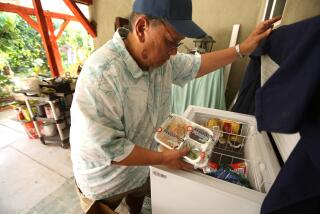State Underpays Many Who Rely on Food Stamps
- Share via
SACRAMENTO — In their rush to comply with the dictates of welfare reform, California counties have shortchanged thousands of poor families on food stamps, prompting the federal government to threaten the state with severe financial penalties.
State surveys show that nearly 13% of the payments made to poor families in 1998 involved a serious miscalculation of the food stamps they were entitled to, an error rate that is one of the highest in the nation.
The errors occurred mostly in counties with large food stamp populations--Los Angeles, San Francisco, Fresno, San Diego, Alameda and Solano.
Critics say these bureaucratic blunders--totaling thousands of dollars a year and affecting thousands of families--may be a contributing factor in California’s stubbornly high hunger rates.
Poor families operate so close to the margin, said Brian Lawlor, regional counsel for Legal Services of Northern California, that the loss of even a few dollars can quickly plunge poor people into hunger. “Food stamps are a primary source of their food buying, and they are already inadequate,” he said. “If they are reduced, say, by $10 or $20 or not paid at all, that’s real serious.”
While acknowledging that the errors are unacceptably high, state and county officials blame the frequency of mistakes on the conflicting requirements of different government aid programs and the failure of Congress to bring the nation’s mammoth food stamp program into line with welfare reform.
Moreover, as welfare reform has pushed more poor families into the workplace, the officials said, keeping track of recipients’ earnings has become a huge task for county workers. It has been particularly challenging, they said, in California, where the program serves 2.2 million people.
When families leave welfare for work, many still qualify for food stamps because their earnings are low.
“We are aiming at getting people to work, and the food stamp program is not conducive to working families,” said Bruce Wagstaff, California’s welfare director. “[But] you can’t neglect the fact this error rate is too high. It’s got to be brought down.”
He said California will probably be assessed $8 million in penalties for its 1998 food stamp mistakes. California’s error rate for that year was higher than the national average of almost 11%, and California was one of the few states with a significant amount of underpayment to recipients. In most states, the errors involved overpayment.
Errors were not counted unless they involved a mistake of $6 or more.
Wagstaff said the state has pressured counties to reduce errors, and early indications are that the rate is down several percentage points in 1999. “[But] in my view it’s still too high,” he said. “We’ve got to make sure people are getting what they should be getting.”
In Los Angeles, Tony Vargas, chief of management, information and evaluation for the county Department of Public Social Services, said the spike in the county’s food stamp error is almost entirely due to changes spawned by welfare reform, especially those affecting immigrants.
Many legal immigrants lost food stamps under welfare reform, but then a state-financed program was created to provide coupons to immigrants under 18 and over 65 who entered the country before Aug. 22, 1996. Later federal legislation allowed some immigrants to get food stamps again.
While aid workers were coping with the on-again, off-again status of immigrants, he said, they were also having to bird-dog the earnings of the thousands of welfare recipients who had moved into the workplace.
“We’re putting more people to work,” Vargas said, “and when you have more earnings . . . it does present an additional workload and it creates a bigger potential for errors, which has happened.”
Federal officials, reportedly harshly critical of California’s error rate in private meetings with state bureaucrats, declined to discuss the issue publicly until penalties are assessed in midsummer.
The food stamp program is financed entirely by the federal government, which sends more than $2 billion a year to Californians, and is administered by the state. It provides coupons that are used like cash at participating grocery stores. Depending on income and assets, a person can receive as much as $122 a month; the average benefit in California is about $70 a month.
California’s plight has drawn national sympathy and helped fuel an effort by the American Public Human Services Assn., which represents welfare agencies, to force changes in the food stamp program that would make it more compatible with welfare reform.
In a briefing paper, the association said the program’s requirement for meticulous tracking of earnings created havoc when welfare recipients moved into entry-level positions where wages fluctuated frequently and jobs changed often. The paper said the program is a disincentive to work because once a family leaves welfare it becomes harder to qualify for food stamps.
“The ex-[welfare] recipient suddenly faces a cliff of much stiffer eligibility requirements that sends an unmistakable message: It is easier if you remain on [welfare],” it said.
Stacey Dean, a senior policy analyst at the Washington-based Center on Budget and Policy Priorities, a think tank for issues involving the poor, said the underpayments to food stamp recipients are troubling, but she fears efforts to correct them could drive more people from the rolls.
To correct errors, she said, states have pressured working families to provide a mountain of paperwork documenting every change in their income and living costs. Many families tire of the hassle, she said, and drop out of the program.
More to Read
Sign up for Essential California
The most important California stories and recommendations in your inbox every morning.
You may occasionally receive promotional content from the Los Angeles Times.










